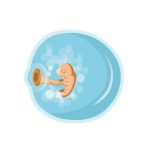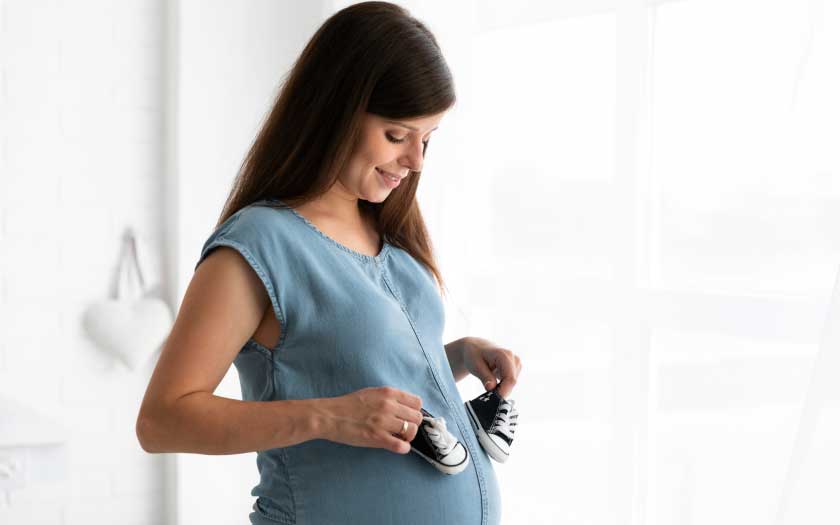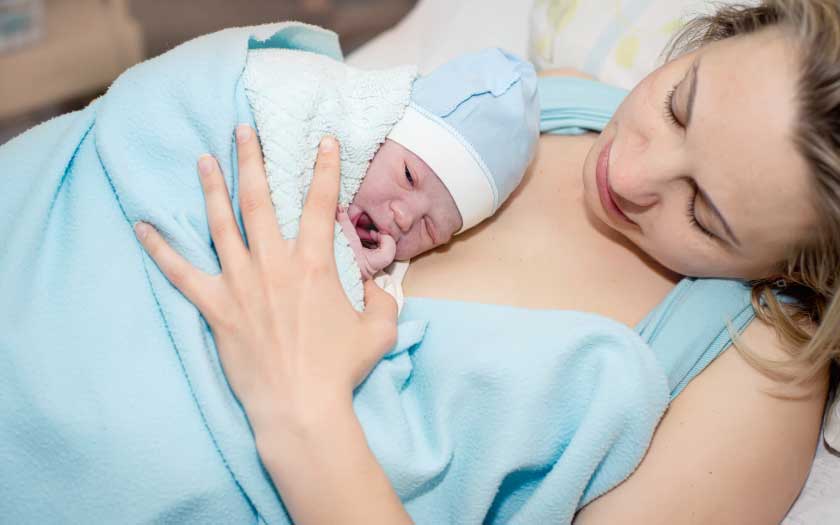So, you’re pregnant? Congratulations! After getting over the initial excitement and shock, you are probably wondering what you can do to support this new life growing inside you now. This special guide is just what you need.
Pregnancy is indeed an exciting time in any woman’s life, for it’s an absolute gift to be able to conceive and give birth, isn’t it? While women have been giving birth since the beginning of mankind, the way we view pregnancy has evolved with the times. Guidance, however, will never go out of style, for every woman wants a healthy, happy pregnancy.
Here, we present to you a special 3-trimester guide, created specially for you. We hope it will make a difference during this special time of your life.

At about the 28th day, your baby (an embryo at this point), will be embedded in the lining of your uterine cavity. Extremely important changes are taking place in the woman’s body at this early stage, although she may be unaware of her pregnancy until she misses her first period. At about half an inch long and already has a recognisable head, it will have a nervous system, body, and the beginning of minute limb buds. Towards the end of the fourth week, the heart begins to beat, although it may not be detected yet on an ultrasound scan.
At about 8 weeks into the pregnancy, your baby will measure about one and a half inches. Vital organs continue to be formed, and the digestive, respiratory, and urinary systems are taking shape. The eyelids have formed but will not open for several more weeks. The ears, ankles, fingers, and toes are just about discernible at this stage.
Your baby’s head is still very large in proportion to the body, although the face is beginning to assume a recognisable shape with depressions present where the eyes are destined to be, and a definite shape to the nostrils. The two sides of both the upper and lower jaw have fused as well, whereby your baby’s mouth can be made out.
The circulatory system has been established and the heart is beating strongly. The lungs, which are formed as tiny, solid organs on each side of the mid-line continue to grow rapidly, but remain solid at this stage.

When your pregnancy reaches the 12-week mark, your baby will be termed as a foetus instead of an embryo. It will be about three-and-a-half inches long and will reach a major milestone as all the vital organs have formed and are beginning to function. This is the critical period when congenital abnormalities are known to occur. Taking in enough folic acid is crucial to prevent this from happening.
You
You may start to suspect around the 28th day or so, that you are pregnant when you miss your period.
At 8 weeks into your pregnancy, you may or may not experience morning sickness (nausea and vomiting may happen at any time during the day). This should subside by the end of the 12th week of your pregnancy. In the meantime, if you do happen to experience morning sickness as part of your pregnancy, try having a carbohydrate-rich snack 15-20 minutes before you get out of bed in the morning – this can help to settle the stomach before you start to move about. Remember to keep some plain crackers or bread by your bed for when you wake up. Tip: Stay away from high fat, fried and spicy foods as these can aggravate nausea.
Important
Ensure you are having at least 10 glasses of water each day plus fluid-filled fruits and vegetables to keep you and baby hydrated
You may also experience some fatigue, frequency of urination as well as tender and enlarged breasts. Many women also develop lower abdominal pains at this time, and these are due to the stretching of the ligaments and muscles of the pelvis. There is often a creamy white discharge from the vagina.
When your pregnancy reaches the 12-week mark, you may be able to feel your enlarged uterus at the lower abdomen as a very soft swelling arising out of the pelvic cavity. Other physical changes may be in the size and shape of your breasts.

There have been studies that demonstrated clear links between a low vitamin-E diet and increased miscarriage risk. So, load up on this important nutrient by adding the following into your diet: raw almonds, avocado, olive oil, sunflower seeds, hazelnuts, and egg yolk.

Your precious baby will continue to grow and develop rapidly. All limbs are properly formed and the joints are moving vigorously. Fingers and toes have assumed their proper shape and the nails are fully formed. While your baby’s head continues to be quite large in proportion to the size of the body, the entire body is undergoing rapid growth at this stage.
All the primary sex characteristics are in place and the sex of your baby can be easily detected through the ultrasound scan. Your baby may also be able to make all sorts of facial expressions.
A fine downy hair (called lanugo) covers the entire surface of the body, including the face. The eyebrows and eyelashes start to grow at around 16 weeks.
At about 20 weeks old, your baby’s head will start to grow hair, and baby will continue to increase rapidly both in length and in weight. Since there is still a relatively large amount of amniotic fluid (the fluid inside the womb), your baby will be able to move around and rotate with ease and to exercise his limbs vigorously. The little one, at this stage, may also be sucking his thumb in your womb!
At about 24 weeks, although all the vital organs are now fully formed and are functioning, your baby’s lungs, however, would not yet have properly matured. Measuring over 12 inches in length and weighing about one-and-a-half pounds, your baby will now have a normal amount of muscle on the legs and arms but may still appear tiny and thin as subcutaneous fat (which gives babies that chubby, cute appearance) have not been deposited yet. At this stage, the baby will be aware of sounds such as music as well as your voice!

In the fourth month of pregnancy, your baby will be about 13 cm long and will weigh 140g (5oz) and the little one’s skeleton will start to harden from rubbery cartilage into bone. Your baby bump should begin to show this month.
Baby’s eyes will begin to open and close by the end of this week, and movement will be vigorous. These movements may feel like sharp thumping on the abdominal wall, and will be interspersed by long periods of quiet rest – yes your baby in the womb needs to rest too!
You
It is during this second trimester, which is the third to sixth month of pregnancy, that you can expect to be at your peak both physically, mentally, and emotionally. Your body would have adjusted perfectly to being pregnant and nausea which you may have been experienced in the first 12 weeks should have subsided by now.
Sometime between the 16th and 20th week, you may be able to feel your baby’s movements for the first time. The medical term for this phenomenon is ‘quickening’ and it is regarded as one of the major milestones of pregnancy.
From about the 12th week of pregnancy, the uterus moves up out of the pelvic cavity and continues to enlarge at a regular rate so that it reaches the umbilicus (belly-button) by around week 22. Your pregnancy will start to show now with a very definite ‘bump’ being visible.
Eat more iron-rich foods
Your blood volume is rapidly increasing (and will increase by 50% by the time you give birth). Increase your intake of good quality proteins like eggs and free-range meats (organic/grass-fed where possible). If you are vegetarian, make sure you are consuming iron-rich plant foods such as leafy greens and legumes with every meal, along with a source of vitamin C (such as a squeeze of lemon juice or some capsicum/peppers) as this enhances the body’s uptake of iron from non-animal sources.

At this point, your baby will be perfectly formed, and the head will be well-proportioned to the rest of the body. If born prematurely at this stage the chances of survival will be more than 95% with intensive nursing care in a high-support premature baby unit.
A large amount of vernix continues to cover the entire body of the baby and while deposits of subcutaneous fat continue to be laid down, he remains relatively thin.
Your baby will, at any time during this stage, settle in an upside-down position within the womb in preparation for birth. Baby’s movements, although vigorous, may not always be so apparent to you, for as the weeks go by, there’ll be limited space in your womb.
During the last phase of your pregnancy, between 38-40 weeks, your baby will be fully developed and would have assumed that characteristic chubby, cute appearance of a new baby due to the laying down of large amounts of subcutaneous fat.
The baby is still covered in a large amount of vernix, and sometimes this vernix is also present in the amniotic fluid.
Medically speaking, this marks the end of a normal pregnancy, but remember, that this is just an average, not a hard and fast rule. Many pregnancies last less than 40 weeks, while some women go into labour as late as the 42nd week!
At 40 weeks, the baby may still be covered in a large amount of vernix, which may be particularly thick on the skin creases around the groin area, armpits, behind the knees, and around the neck. The only parts of the body where the vernix is not present is around the mouth and on the eyes. The fine downy hair (called lanugo) which covers the entire surface of the baby’s body from about 16 weeks, has almost disappeared by the end of the pregnancy, but may still be present over the shoulders and on the arms, legs and occasionally across the forehead.
Babies are always born with certain eye color, but the color may change within minutes of delivery. The fingernails and toenails protrude exactly to the ends of the fingers and toes, but not beyond. They are also very soft, so they cannot damage their delicate skin by scratching during the first 24 hours of life.
The average weight of a full-term baby is 2.5 to 3.5 kilograms. Babies who weigh less than 2kilograms at birth are described as ‘low birth weight babies’ and are likely to need intensive nursing care in the first few days of life.

You have now entered the third trimester of your pregnancy and this is the time when you will be likely to experience feelings of tiredness and discomfort due to your rapidly expanding girth and the unprecedented growth of your baby. You may encounter problems associated with the growing pregnancy — low back pain, constipation, frequent urination, and ankle swelling. Varicose veins may become more prominent at this time. Stretch marks may also be visible, especially on your belly.
You may feel “slowed down” at this time because of the size of your bump, and may also notice increasing contractions of the womb muscle (Braxton Hicks contractions).
In over 50% of women having their first baby, the head descends (or engages) into the pelvis at this stage in preparation for the birth. This is referred to as ‘lightening’ and usually results in a considerable relief of pressure in the upper abdomen of the mother. It is quite significant when it occurs, but there is no cause for concern if it fails to happen.
Enjoy your new life as a mother!








